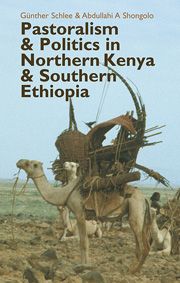Book contents
- Frontmatter
- Contents
- List of Maps and Figures
- List of Abbreviations
- Introduction
- 1 Moi Era Politics, Transnational Relations and the Territorialization of Ethnicity
- 2 The Post-Moi Period 2002–2007
- 3 Feedback and Cross-fertilization: The ‘Declaration of Indigenous Communities of Moyale District’
- 4 Some Comparative Perspectives, Conclusions and Recommendations
- References
- Index
- EASTERN AFRICAN STUDIES
4 - Some Comparative Perspectives, Conclusions and Recommendations
Published online by Cambridge University Press: 05 September 2013
- Frontmatter
- Contents
- List of Maps and Figures
- List of Abbreviations
- Introduction
- 1 Moi Era Politics, Transnational Relations and the Territorialization of Ethnicity
- 2 The Post-Moi Period 2002–2007
- 3 Feedback and Cross-fertilization: The ‘Declaration of Indigenous Communities of Moyale District’
- 4 Some Comparative Perspectives, Conclusions and Recommendations
- References
- Index
- EASTERN AFRICAN STUDIES
Summary
‘In 1980 Isiolo District was flooded by pastoral Somali from Wajir and Mandera districts who were fleeing from constant harassment by their fellow Somali, who roamed about, robbing and raping at gunpoint’ (Schlee 1989a p. 52). The problem is older than the breakdown of the Somali state in the late 1980s which led to the dictator Siad Barre having to flee the country in 1991 and the subsequent faction fighting and mass emigration. It is older even than 1980, when I made this observation about the state of affairs in Isiolo District.
The recommendation of Boran politicians derived from such states of affairs is forced repatriation of Somali to their presumed districts of origin. They claim the districts in which Boran predominate numerically to belong to the Boran. They cannot even be blamed for this. Murder, arson and looting by the politically dominant ‘Kalenjin’, which led to the expulsion of immigrants originating from other parts of the country from Rift Valley Province in the early 1990s, have set the precedent. If other ‘tribes’ claim to have privileged access to the resources of what they perceive as their territories, why should the Boran be the last ones to do so? All the more so as in neighbouring Ethiopia ethnic territoriality is not only the actual practice but written into the constitution.
- Type
- Chapter
- Information
- Pastoralism and Politics in Northern Kenya and Southern Ethiopia , pp. 145 - 164Publisher: Boydell & BrewerPrint publication year: 2012



